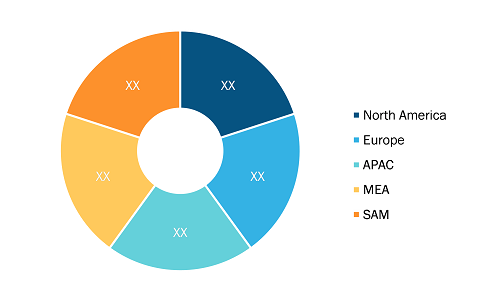According to our latest research study on “Wire Rod Market Forecast to 2028 – COVID-19 Impact and Global Analysis – by Material, Industry, and Geography,” the market is expected to grow from US$ 1,621.27 million in 2022 to US$ 1,965.21 million by 2028; it is estimated to register a CAGR of 3.3% from 2022 to 2028.
A wire rod is made by drawing hot metal through shafts. These shafts form and compress the metal from all sides, thus turning a piece of metal into a long and thin wire. They have round cross-sections and are wound up in the coil. They act as excellent raw materials for high-voltage cable and wire manufacturing. These wire rods are used to carry loads, electricity, and telecommunications signals. They are used in various sectors, including electrical, infrastructure, aviation, telecommunication, and automotive. For example, wire rod is used in multiple electronic components, such as electrical panel board switches and relays, PCB plug pins, sockets, and terminal blocks.
Wire Rod Market Share – by Region, 2022
Wire Rod Market Size and Forecast (2021 - 2031), Global and Regional Share, Trend, and Growth Opportunity Analysis Report Coverage: By Material (Copper, Aluminium, and Others), Industry (Telecommunication, Power, Aviation, Automotive, and Others), and Geography
Wire Rod Market Drivers and Trends by 2031
Download Free Sample
Since wire rod is a raw material used for fabricating wire drawing units, it is also used for making springs, wire ropes, barbed wires, electrodes, fasteners, and wire mesh, as well as automobile components and hardware tools. Therefore, manufacturing of such large number of semi-finished products is expected to fuel the wire rod market growth.
The demand for wire rods is increasing due to the growing construction and infrastructure development activities across the globe. Furthermore, the growing number of residential, commercial, and industrial developments is creating the need for wire rods for efficient power supply, data conductivity, and security. In addition, the rising investment in the high voltage power transmission distribution is further fueling the wire rod market growth.
Another key factor attributing toward the rise of wire rods is the high production of copper and aluminum. Copper and aluminum are majorly used to manufacture wire rods, followed by pipe and rolled products. Large production of copper and aluminum wire rods would endure to address the demand coming from construction and other industrial sectors in the coming period.
Impact of COVID-19 Pandemic on Wire Rod Market
COVID-19 pandemic severely impacted the manufacturing industry. In 2020, the rapid spread of the novel coronavirus infection urged governments across the world to impose strict restrictions on human movements. Travel bans, mass lockdowns, and business shutdowns adversely affected economies and countless industries in various countries. The imposition of lockdowns resulted in the lesser production of commodities, goods, and services. Automobile, aviation, manufacturing, and several industries witnessed a decline in operations due to the temporary suspension of production activities. Wire rod manufacturers also experienced a slowdown in manufacturing facilities, as they were operating with a limited workforce.
As industries reopened from early 2021, the use of wire rod started to rise at a gradual pace. Factories resumed their work in 2021, resulting into almost all industries began production on the full scale. In 2021 and 2022, the relaxation of lockdown measures and the resumption of construction activities in urban areas positively impacted the wire rod market. According to the World Bank Group data, by 2045, the global urban population will increase to 6 billion. Due to the increase in the urban population, the demand for residential and commercial construction will also increase, which drives the demand for wire rods. Also, the growing construction of power plants and manufacturing facilities will further drive the market growth during the forecast period.
Additionally, one of an enduring effect of the pandemic is shortage of semiconductors at a global level. The shortage has prompted the companies and governments to take preventive measures from avoid facing such shortages again. Moreover, as per the Denso’s and MIT analysis, it has been observed that in the US, rising number of semiconductor fabrication facilities are not sufficient. Therefore, to avoid such situation from occurring in the future includes focus on resiliency, looking beyond advanced chips; make optimal utilization of current supplies; and determine common chip standards, and other parameters is required. Overlook on mentioned parameters would assist in mitigating the situation of shortage of semiconductor in regions.
The global wire rod market size is segmented on the basis of material, industry, and geography. Based on material, the wire rod market is bifurcated into copper and aluminum. Based on industry, the wire rod market is segmented into telecommunication, power, aviation, automotive, and others. The wire rod market size, based on region, is segmented into North America, Europe, Asia Pacific (APAC), the Middle East & Africa (MEA), and South America (SAM).
Mitsubishi Materials Trading Corp, APAR Industries Ltd, Hindalco Industries Ltd, Norsk Hydro ASA, Leebo Metals Pvt Ltd, Sumitomo Electric Industries Ltd, Vedanta Aluminium and Power Ltd, United Co RUSAL Plc and Vimetco NV are among the key wire rod market players operating in the industry. During this study, several major wire rod market players were analyzed to get a holistic view of the global market and its ecosystem.
Contact Us
Phone: +1-646-491-9876
Email Id: sales@theinsightpartners.com